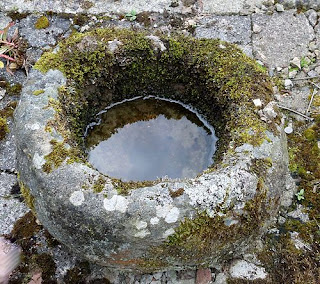A large pot-shaped cavity known as "knocking well" was cut into exposed bedrock or boulders. Grain was then poured into the cavity and pounded with a rounded stone or with a hardwood (oak) mell... These were basically bedrock mortars...
One example of a knocking stone at the old St Macarius chapel site of Mackrikil near Dailly in Ayrshire has a prominent cross carved on one side. Locally it was known as the 'font' and that indicates an understandable confusion with a stoup used to hold holy water for baptism...
Well, maybe not a confusion. In Ireland these kind of stones are called Bullaun stones. And there they are "definitely not mortars"...They are holy stones used for blessing and cursing. And when they get filled with rain water, the water acquires miraculous healing properties...
The fact that the same kind of stones like Bullaun stones (pounding stones) were in Scotland used as mortars means nothing in Ireland. The Irish are different... 🙂
I wrote an article about Bullaun stone being mortars few years ago...Which was then followed by another article about Middle Eastern and Mediterranean Bullaun stones...
These stone mortars were considered holy not just in Ireland and Scotland. In South Baltic region they were buried in the house foundations to protect the household...
I talked about this in my post "Stones with narrow bottomed bowls".
This stone from Latvia is called "Lielais Daviņu Akmens" which means great stone of giving, offering, great altar. It seems that the stone was linked to harvest rituals. For the farmers, anything to do with sowing, harvesting, grinding, eating grain had religious significance...
We know this from ethnographic records. This includes tools used for ploughing, sowing, harvesting, grinding grain and making bread. They all had religious significance and were seen as possessing supernatural powers...
Large bedrock stone mortars were communal tools. Once made they could last for generations. This definitely made them special in the eyes of the farmers who used them. These mortars, being permanent in the impermanent world, must have eventually become holy...
Which is why rain water, water that comes from heaven, accumulated in bedrock mortars was also holy and was used in religious, especially healing ceremonies...
Which is why large boulder mortars were moved to churchyards where a lot of them were turned into holy water fonts. Well they already were holy water fonts even before Christians appropriated them...
I wonder if Christian stone fonts, like this Norman font from St Nonna's Church at Altarnun, UK, developed from stone mortars filled with rain water...This one is particularly interesting because it is decorated with Perunikas, flowers of Perun, Slavic thunder, rain god.
I talked about this symbol in my posts "Burning rolling wheel", "Ognjena Marija" and "Archangel Michael"...
This symbol is also known as Flower of life...Because it is rain that makes grain grow, makes life possible??? Bread of life anyone???
That this Norman font is not just a once off weirdness, have a look at this article: "St Austell font"...






It's just something incredible! Thanks for your work!
ReplyDeleteAlso, there are many sacred stones looking like these in Lithuania, and several monographs by dr. Vykintas Vaitkevičius about them.
ReplyDeleteInteresting how people from multiple areas had a similar view of these mortars (knocking stones). Have to wonder what went through the minds of those spending so much time at these mortars, as they pounded-out the much needed food. Likely similar thoughts across many areas of Europe.
ReplyDelete